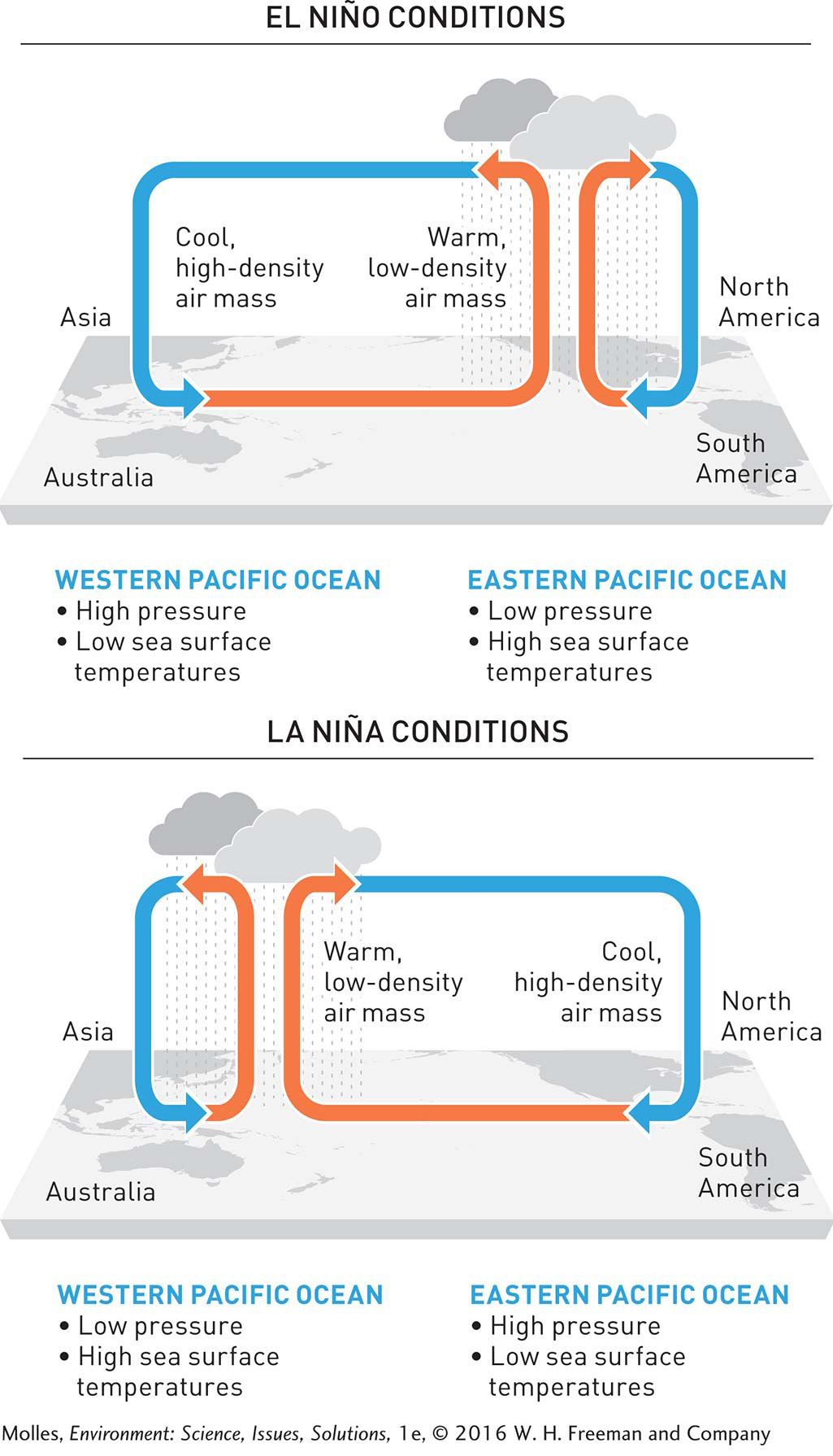6.2 The El Niño Southern Oscillation causes periods of dry years and wet years
161
Every three to five years, on average, the equatorial Pacific Ocean off the coast of South America warms up by a few degrees, leading to significant changes in rainfall around a large part of the globe. This phenomenon, known to the fishermen of Peru for centuries, brought with it torrential rains, flooding on land, and poor fishing at sea. Because the periodic warming generally occurred during Christmastime, the local fishermen named it “El Niño,” the Spanish name for Jesus Christ as a child. Other observers noted that droughts also seemed to come and go in cycles.
El Niño Southern Oscillation
An oscillating climatic system involving variation in ocean surface temperatures and barometric pressures across the Pacific Ocean.
upwelling The movement of cold subsurface water to the ocean’s surface when warmer surface waters move offshore under the influence of prevailing winds.
El Niño A period of warmer than average sea surface temperatures and lower barometric pressure in the eastern Pacific Ocean, favoring the production of storms in the eastern Pacific Ocean.
Today, we recognize the El Niño Southern Oscillation as one of the most important influences on atmospheric circulation and surface temperatures across the Pacific Ocean. During typical conditions in the tropical Pacific, the trade winds, which blow from the east, push warm surface water westward. As this water moves westward, cold water from the bottom of the ocean on the west coast of South America is drawn up to the surface, in a process called upwelling. However, as El Niño conditions develop, the trade winds weaken and the warm surface water flows in the opposite direction—
Such changes in atmospheric circulation and ocean surface temperatures influence the hydrologic cycle globally. The warmer than average sea surface temperatures during an El Niño are accompanied by low atmospheric pressure in the eastern Pacific Ocean. These physical conditions favor the production of storms in the eastern Pacific Ocean, as the water vapor in the warm rising air condenses to form storm clouds. When this happens, conditions are wet and cool across the southern portion of the United States and northern Mexico during December through February. Meanwhile, Southeast Asia and Australia are dry. So, while the southeastern United States faces torrential rains and flooding, Southeast Asia and Australia brace for drought and wildfires. The climatic conditions associated with El Niño generally persist for a year, sometimes two, before the climate swings back toward average conditions or beyond, to the opposite climatic extreme.
La Niña A period of lower than average sea surface temperatures and higher barometric pressures in the eastern Pacific Ocean, resulting in reduced storm activity in the eastern Pacific Ocean.
The opposite of the El Niño is now known as La Niña, which develops about as frequently as El Niño—


What are the disadvantages of living in a region strongly connected to the El Niño Southern Oscillation system? Might there be advantages?
It took scientists most of the 20th century to piece together the global impact of El Niño and La Niña. Based on tree ring data, which correlates with precipitation amounts, and other evidence, scientists estimate that El Niño-
162
There is at present no clear consensus among climate scientists as to how climate warming (see Chapter 14, page 443) will influence the intensity and frequency of El Niño and La Niña. While some climate models predict higher frequencies and intensities of these events, other climate models predict the opposite. Regardless, the long geologic history of this system suggests that the El Niño will continue to affect Earth’s weather. From a water supply perspective, those regions under the influence of the El Niño experience much greater fluctuation in precipitation than do regions outside of its influence.
Think About It
The onset of an El Niño or La Niña can now be predicted several months in advance. How might this predictive capability be used to the advantage of water planners?
How might water planners and managers adjust to the challenges presented by the climatic variation associated with El Niño and La Niña?
6.1–6.2 Science: Summary
The hydrologic cycle, which is powered by the Sun, moves Earth’s water across the biosphere and strongly influences sustainable water supplies. The oceans form the largest reservoir of water on Earth, followed by polar ice caps and glaciers, groundwater and freshwater lakes and rivers, and the atmosphere. Approximately one-